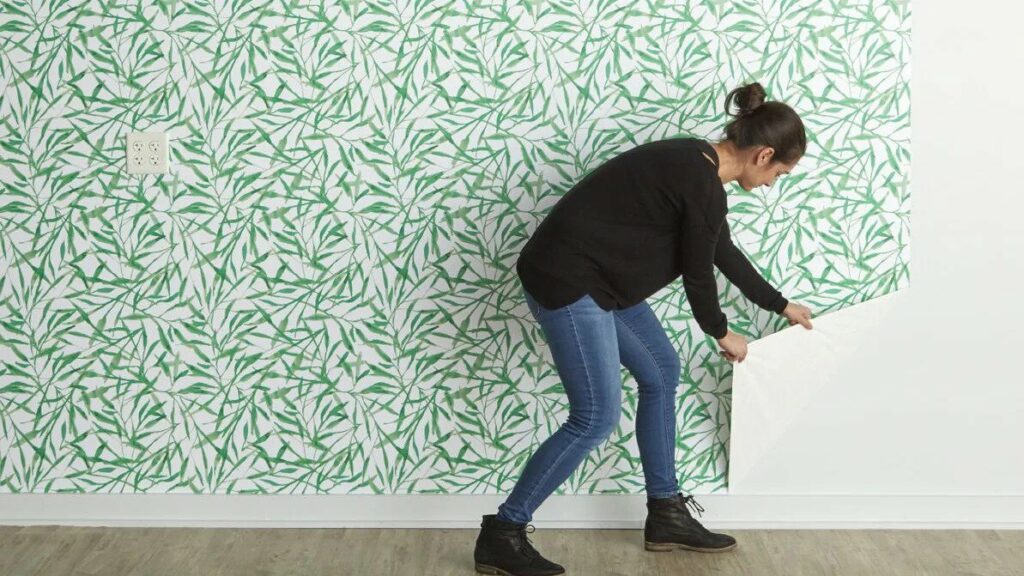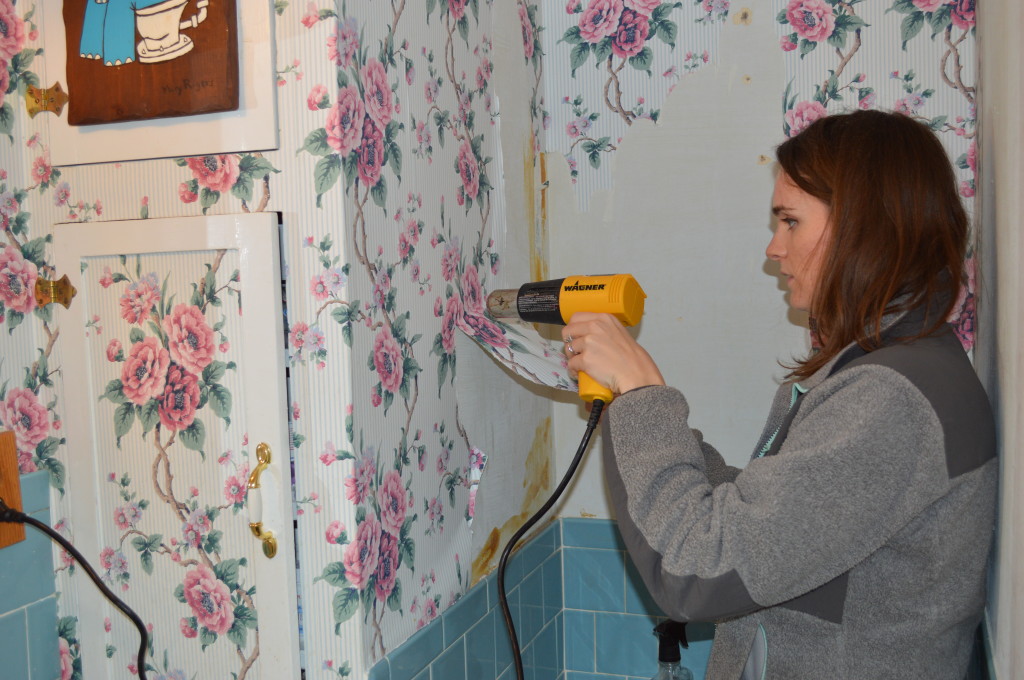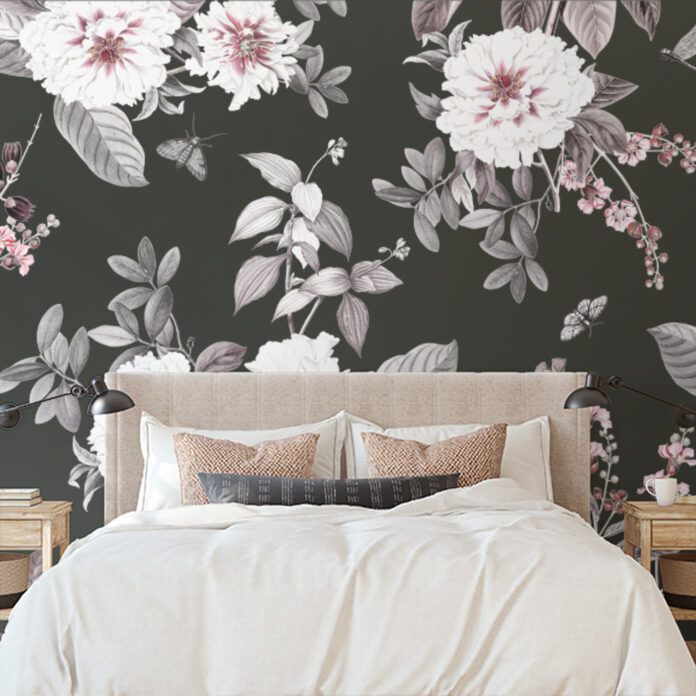If you’re looking to remove peel and stick wallpaper, you’re in luck! Peel and stick wallpaper removal is even easier than installing it. We’ve put together an in-depth guide to help you remove your wallpaper without causing any damage. If you’d like to see a video demonstration of the Peel and stick wallpaper removal, check out the video below. For more detailed instructions, read on for tips and tricks to help you easily remove your wallpaper. Applying peel and stick wallpaper and removals are both easy.
How to Remove Peel-And-Stick Wallpaper?
Prepare the Room
Before you start the process of removing the wallpaper, it’s important to prepare your room. Begin by moving furniture away from the walls to create enough space for you to work.
If you have high walls and need a ladder or step stool to reach the top, make sure you have one on hand.
Additionally, remove any outlet covers, light switch covers, or wall decor from the walls to make the removal process smoother and faster. Once everything is in place, and your workspace is clear, you’re ready to remove the wallpaper.
Start From the Corners

Once you have your room prepared and all obstacles removed, you can begin the process of removing the wallpaper. It’s usually best to start in the corners of the room.
Remember that although the wallpaper is designed not to damage your walls as it comes off, it is durable and tear-resistant, so it may be easier to locate the edges of each panel rather than trying to cut into the wallpaper during removal.
If you have trouble getting one of the corners to start peeling, you can use a small blade or thin tool to gently lift the corner of the wallpaper until you can grab it.
It’s a good idea to do this at the top corner of the wall or in another less noticeable area in case your tool leaves a small mark on the wall. Once you’ve started peeling the wallpaper from the corner, you can continue to remove it from the wall.
Peel in The Same Direction As the Installation
When removing peel and stick wallpaper, it’s usually best to move in the same direction as you did during installation. This can make the process smoother and more efficient, especially if panels have slightly overlapping edges.
Moving in the same direction as during installation of peel and stick wallpaper, the panels are more likely to come off in a single piece as you peel, making the removal process even easier and faster.
However, if the panels do not stick together, you can use the method described above to locate the corners of each panel and remove the wallpaper in increments.
Remember to take your time and be patient during the removal process, and you’ll be able to easily remove your wallpaper without causing any damage to your walls.
Have Patience and Give it Some Time & Effort
One important tip for removing peel and stick wallpaper is to be patient and slow. While the removal process will be faster than the installation, taking your time will help you avoid tears, rips, or other issues that might arise.
This is especially important if you have wallpaper that has been up for a long time, as the adhesive may sometimes react differently on every surface.
Moving too quickly may create sticky spots or damage the paint on the walls, so it’s best to take it slow and peel off the wallpaper in sections similar to those you used during installation (18-24 inches).
We also recommend peeling the wallpaper down the wall instead of up, rolling, or folding it as you go. This will keep excess peeled wallpaper out of your way and allow gravity to help you move downward, although you can remove the wallpaper in any direction that works best for you.
The key is to be patient and take time to ensure a smooth and damage-free removal process.
Observe the No Residue and Easy Removal of Peel and Stick Wallpaper

Once you’ve finished removing the peel and stick wallpaper, you’ll be left with a clean, blank canvas for new designs with no adhesive residue and no damage to the walls.
When you’re done, you can easily dispose of the wallpaper. Our wallpaper is environmentally friendly and biodegradable over time, so you can recycle it rather than throw it away.
Additionally, our wallpaper is non-toxic and contains no PVC, glycol-ether, formaldehyde, or phthalates, so you can feel good about recycling it.
However, the panels are not designed to be reused, so once you’ve removed them from the wall, they are unlikely to stick to other surfaces.
Keep these things in mind as you complete the wallpaper removal process, and you’ll be able to remove your wallpaper without any issues easily.
Other Methods to Remove Peel and Stick Wallpaper
Sometimes we get into trouble to take off peel and stick wallpapers because of their materials, but don’t worry; we are here for you.
There are two main methods for removing peel and stick wallpaper: the Cold Pull method and the Heat Method. Both methods involve using a craft knife to assist with the removal process.
Cold Method
To use the Cold Pull method, start by lifting a corner of the wallpaper, beginning with the panel installed last. You can use your fingernails or a craft knife to do this.
- Once you’ve pulled away enough to get a firm grip, start pulling the wallpaper panel off the attached surface.
- Try to pull at an angle of 45° or less away from the surface you’re removing it from.
- A larger angle can increase the chances of adhesion or residue.
- Pull as evenly and slowly as possible, and repeat this process until you’ve removed all the panels.
The wallpaper may be harder to remove if you’re working in a cold environment. In this case, you can use the Heat Method to make the process easier.
Heat Method

- To use the Heat Method, heat the wallpaper for 30-60 seconds using a heat source, being careful not to hold it too close (about 15-30 cm away).
- You can also use a portable fan heater to heat the entire room before starting the removal process.
- Once the wallpaper is heated, follow the steps for the Cold Pull method, lifting a corner and pulling slowly.
- If the wallpaper becomes difficult to remove, stop and reheat the surface as needed.
How to Remove Peel and Stick Wallpaper Residue
If you’re having trouble removing all of the adhesive residues after removing peel and stick wallpaper, here are a few things you can try:
- Use a scraper or putty knife to gently scrape off any remaining adhesive. Be careful not to scratch or damage the walls as you do this.
- Mix a solution of equal parts hot water and white vinegar, or use a commercial wallpaper removal solution according to the manufacturer’s instructions. Apply the solution to the residue using a sponge or cloth, and let it sit for a few minutes to soften the adhesive. Then, gently scrape off the residue with a scraper or putty knife.
- If the above methods don’t work, you can use a de-glosser or a citrus-based cleaner to remove the residue. Apply the de-glosser or cleaner to the walls according to the manufacturer’s instructions, and let it sit for a few minutes to soften the adhesive. Then, gently scrape off the residue with a scraper or putty knife.
- You can use a chemical adhesive remover if the adhesive residue is still not coming off. Follow the manufacturer’s instructions carefully when using this product, as it may be harsh and potentially damage the walls if not used properly.
Remember to be careful when removing adhesive residue and to take necessary precautions, such as wearing gloves and protective eyewear. If you are having difficulty removing the residue, seek the assistance of a professional.
Frequently Asked Questions
How Easy Is It To Remove Peel And Stick Wallpaper?
Removing peel and stick wallpaper is generally easier than removing traditional wallpaper. This is because the adhesive used for peel and stick wallpaper is not as strong as the adhesive used for traditional wallpaper, so it is less likely to damage the walls or leave behind residue when it is removed.
How Hard Is It To Remove Peel And Stick Wallpaper?
Peel and stick wallpaper is generally easier to remove than traditional wallpaper removal because the adhesive used for peel and stick wallpaper is not as strong as the adhesive used for traditional wallpaper. This means it is less likely to damage the walls or leave behind residue when removed.
However, the difficulty of removing peel and stick wallpaper can vary depending on many factors, including the age of the wallpaper, the condition of the walls, and the type of adhesive used. Generally, the older the wallpaper, the more difficult it may be to remove.
If the walls are in good condition and the adhesive used for the wallpaper is not particularly strong, the wallpaper should come off relatively easily.
On the other hand, if the walls are in poor condition or the adhesive is particularly strong, the wallpaper may be more difficult to remove. In general, removing peel and stick wallpaper is a relatively easy task as long as you take your time and follow the proper steps.
ALSO CHECK: COMPLETE MODERN HOME DECOR IDEAS




